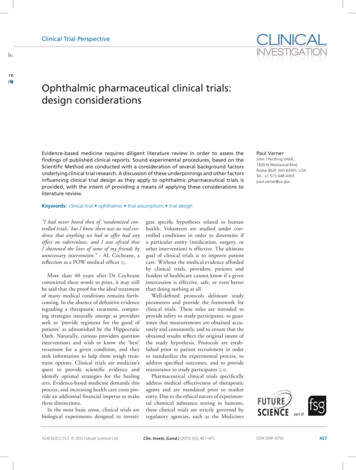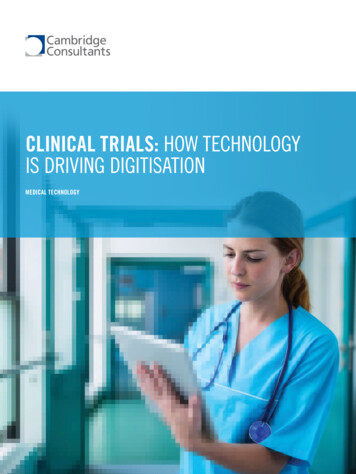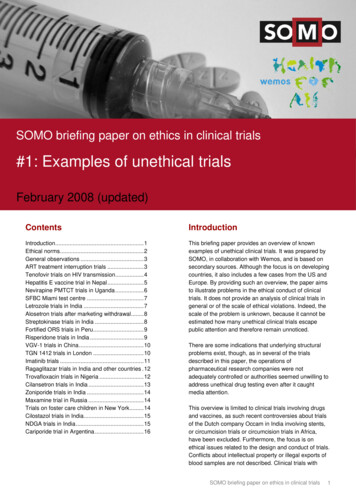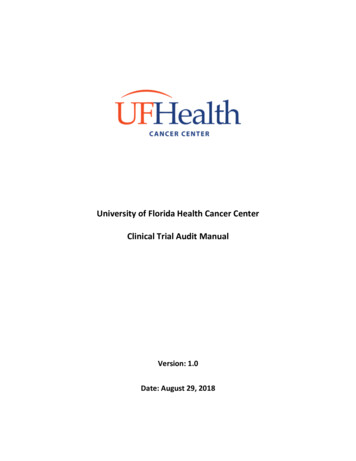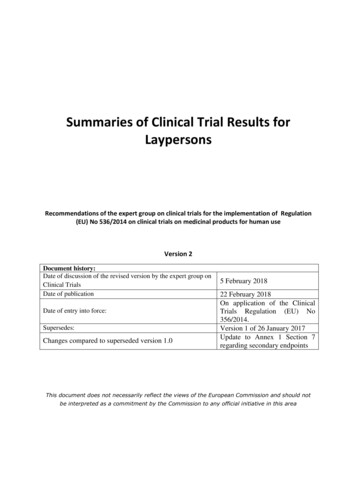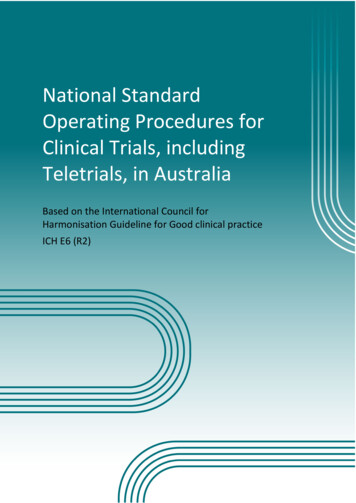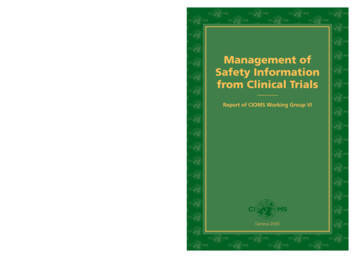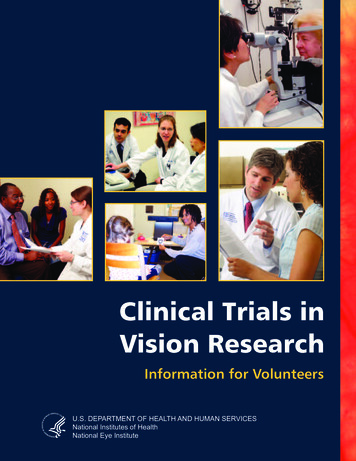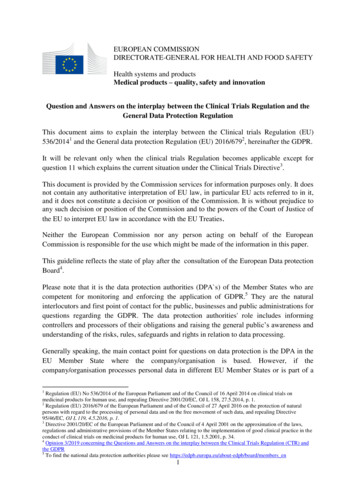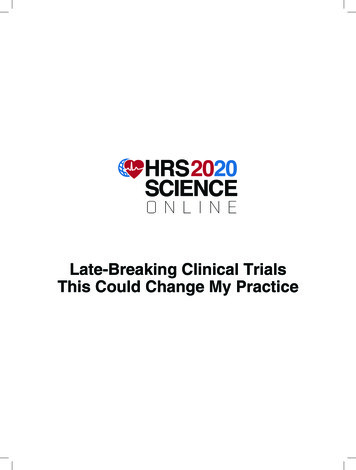
Transcription
Late-Breaking Clinical TrialsThis Could Change My Practice
1D-LBCT04Late-Breaking Clinical TrialsThis Could Change My PracticeCHAIR:Jodie L. Hurwitz, MD, FHRS. North Texas Heart Center,Dallas, TXCOMMENTATOR:Nassir F. Marrouche, MD, FHRS. Tulane University Schoolof Medicine, New Orleans, LACOMMENTATOR:Roderick Tung, MD, FHRS. University of Chicago, Chicago,ILD-LBCT04-01COMPARISON OF OUTCOMES AMONG PATIENTSIMPLANTED WITH A TINED, LEADLESS VERSUSTRANSVENOUS SINGLE-CHAMBER VENTRICULARPACEMAKER IN THE NOVEL MICRA COVERAGEWITH EVIDENCE DEVELOPMENT STUDYJonathan P. Piccini, MD, MHS, FHRS, Kael Wherry, Lindsay Bockstedt, PhD, George H. Crossley, MD, FHRS, KurtStromberg, MS, Jennifer Hinnenthal, MPH and MikhaelF. El-Chami, MD, FHRS. Duke University Medical Center,Durham, NC, Medtronic, Mounds View, MN, Medtronic,Minneapolis, MN, Vanderbilt Heart & Vascular Institute,Nashville, TN, Emory University, School of Medicine, Atlanta,GAIntroduction: The safety and efficacy of the Micra leadlesspacemaker have been demonstrated in multiple clinical trials. Performance of the device in a large, real-world population with a contemporaneous comparison to transvenouspacemakers has not been examined. We sought to compare patient characteristics and chronic (6-month) complications among patients implanted with Micra leadless VVIpacemakers (M-VVI) and transvenous VVI pacemakers(TV-VVI) in the U.S. Medicare population.Methods: The Micra Coverage with Evidence Development(CED) Study is a prospective, longitudinal study designedto evaluate the effectiveness of the M-VVI pacemaker in theMedicare population. The Micra CED Study protocol wasapproved by the Centers for Medicare and Medicaid Services to meet national coverage requirements and enrollsall Medicare Fee-for-Service patients implanted with M-VVIand TV-VVI. To allow for 6 months of follow up, patientsimplanted with M-VVI between the first date of Medicarecoverage, March 9, 2017, and June 30, 2018 were identified using Medicare claims data linked to manufacturer device registration data. All TV-VVI patients from facilities withM-VVI implants during the study period were obtained directly from the Medicare claims. Patients with less than 12months of continuous enrollment in Medicare prior to M-VVIor TV-VVI implant and patients with evidence of a priorCIED were excluded. Relevant pre-specified complicationsincluding dislodgement, infection, and pocket complicationsHeart Rhythm 2020were identified using procedure and diagnostic codes. Unadjusted Fine-Gray competing risk models and models adjusted with propensity score overlap weights were used tocompare chronic complications between treatment groups.Applications: There were 3,726 M-VVI and 7,246 TV-VVIpatients implanted during the study period. Compared toTV-VVI patients, the M-VVI patients were more likely tohave ESRD (12.5% vs. 2.3%, P 0.0001), renal dysfunction (48.7% vs. 41.5%, P 0.0001), and a higher CharlsonComorbidity Index score (5.1 vs. 4.5, P 0.001). Patientsimplanted with a M-VVI had a significant reduction in chronic complications compared to patients implanted with a TVVVI (adj. HR, 0.34, 95% CI, 0.28-0.43, P 0.0001; unadj.HR, 0.38, 95% CI, 0.31-0.47, P 0.0001). Acute (30-day)effusion/perforation/tamponade was not significantly different between the M-VVI and TV-VVI patients.Next Steps/Future: Despite the M-VVI patients havingmore comorbidities than TV-VVI patients, the leadlesspacemaker population experienced a 66% reduction inchronic complications in this first real-world, contemporaneous, comparative effectiveness study.D-LBCT04-02PREDICTED BENEFIT OF THE IMPLANTABLECARDIOVERTER DEFIBRILLATOR: THE MADIT-ICDBENEFIT SCOREArwa Younis, MD, Jeffrey J. Goldberger, MBA, MD, Valentina Kutyifa, MD, PhD, FHRS, Wojciech Zareba, MD, PhD,Helmut U. Klein, Mehmet K. Aktas, David T. Huang, MD,FHRS, James P. Daubert, MD, FHRS, N. A. Mark Estes,David S. Cannom, MD, FHRS, Scott McNitt, MS, BronislavaPolonsky and Ilan Goldenberg, MD. University of Rochester Medical Center, Rochester, NY, University of MiamiMiller School of Medicine, Miami, FL, University of Rochester Medical Center, Rochester, NY, University of Rochester Medical Center, Rochester, NY, University of RochesterSchool of Medicine, Rochester, NY, University of Rochester, Rochester, NY, University of Rochester Medical Center,Rochester, NY, Duke University Medical Center, Durham,NC, New England Medical Center, Boston, MA, Keck Schoolof Medicine at USC, Los Angeles, CA, University of Rochester Medical Center, Clinical Cardiovascular Research Center,Rochester, NYIntroduction: The benefit of the ICD for primary prevention is not uniform. We present the first prediction model forICD-Benefit that integrates the predicted risk for arrhythmicevents vs. non-arrhythmic mortality in all ICD patients enrolled in the MADIT trials.Methods: For the purpose of this study we established theMEGA-MADIT Database, combining all landmark MADIT trials (MADIT-II, MADIT-Risk, MADIT-CRT, and MADIT-RIT).Best-subsets Fine-and-Gray analysis was used to developprognostic models for ventricular tachyarrhythmic events(VTE) (event of interest) or death without prior VTE (competing event). The two competing risk models were subsequently integrated to form the MADIT-ICD Benefit Score.Applications: Eight clinical factors (male, age 75 years,prior non-sustained VT, LVEF 20%, no aspirin, no beta-blocker, and digitalis or diuretic use) were identified aspredictors of VTE; and 5 clinical factors (age 75 years,
2prior CABG, diabetes, HF hospitalization, amiodarone use)as predictors of death without prior VTE (Fig. 1A). The twocompeting models were combined to form the MADIT-ICDBenefit Score (Fig. 1B). Increasing ICD Benefit Score wasdirectly correlated with the 4-year predicted risk of VTE,and inversely correlated with the 4-year predicted risk ofdeath without a prior arrhythmia (Fig. 1C and D, respectively). Thus, patients in the Highest MADIT-ICD BenefitGroup had the highest predicted risk of VTE and the lowestpredicted risk of death without a prior arrhythmia (29 vs.7%, respectively; p .0001), with the highest potential forlife-years saved by the ICD. In contrast, patients in the Lowest MADIT-ICD Benefit Group had a similar risk of VTE vs.death without a prior arrhythmia (19% vs. 18%, respectively; p 0.72), with the lowest potential for life-years saved bythe ICD. Internal validation confirmed model stability withsimilar C indices (0.66 and 0.67).Next Steps/Future: Based on the landmark MADIT trials,we propose the MADIT-ICD Benefit Score which predictsthe likelihood of ICD benefit through personalized assessment of the risk of VTE weighed against the risk of non-arrhythmic mortality. The Score may be used for shared decision-making in potential ICD candidates.Heart Rhythm 2020ing arrhythmic eventin LQTS patients.Methods: The Rochester-based LQTS Registry includedthe phenotypic cohort of 1,509 LQTS patients with QTc 470ms, and the genotypic cohort of 1,288 patients with asingle LQT1, LQT2, or LQT3 mutation. We developed twoseparate risk prediction models which included pre-specified time-dependent covariates of beta-blocker use, syncope (never, syncope while off beta blockers, and syncope while on beta blockers), sex by age and 13 years,baseline QTc, and genotype (for the genotypic cohort only).Follow-up started from enrollment in the registry and wascensored at each patient’s 50th birthday, date of death dueto reasons other than sudden cardiac death, or last contact, whichever occurred first. The predictive models wereexternally validated in an independent cohort of 1,481 genotyped LQTS patients from Pavia, Italy.Applications: In Rochester dataset, there were 77 endpoints in the phenotypic cohort during a median follow-upof 9.0 years, and 47 endpoints in the genotypic cohortduring a median follow-up of 9.8 years. The time-dependent extension of Harrell’s generalized C-statistics for thephenotypic model and genotypic model were 0.784 (95%CI: 0.740 - 0.827) and 0.785 (95% CI: 0.721 - 0.849), respectively, in the Rochester cohort. In the Pavia cohort, 57patients developed the endpoint. The C-statistics obtainedfrom external validation in the Pavia cohort were 0.700(95% CI: 0.610-0.790) and 0.711 (95% CI: 0.631-0.792) forthe two models, respectively. Based on the above models,an online LQTS risk calculator estimating a 5-year risk oflife-threatening arrhythmic events was developed.Next Steps/Future: This study developed two risk prediction algorithms for phenotype and genotype positive LQTSpatients separately. The estimated 5-year absolute risk canbe used to quantify a LQTS patient’s risk of developinglife-threatening arrhythmic events and thus assisting in clinical decision making regarding prophylactic ICD therapy.D-LBCT04-03ASSESSMENT OF ABSOLUTE RISK OF LIFETHREATENING CARDIAC EVENTS IN LONG QTSYNDROME PATIENTSWojciech Zareba, MD, PhD, Meng Wang, PhD, Derick R.Peterson, PhD, Vincenzo Bangardi, PhD, Scott McNitt, MS,Eleonora Pagan, MSc, David Q. Rich, PhD, Valentina Kutyifa, MD, PhD, FHRS, Spencer Zachary Rosero, AndreaMazzanti, MD, Silvia G. Priori, MD, PhD and Ilan Goldenberg, MD. University of Rochester Medical Center, Rochester, NY, University of Milan-Bicocca, Milan, Italy, Universityof Rochester Medical Center, Rochester, NY, ICS Maugeri,Pavia, Italy, University of Pavia & ICS Maugeri, Pavia, Italy,University of Rochester Medical Center, Clinical Cardiovascular Research Center, Rochester, NYIntroduction: Risk stratification in long QT syndrome(LQTS) patients is important for optimizing patient care andinforming clinical decision making. We developed a modelfor prediction of 5-year absolute risk of the first life-threaten-D-LBCT04-04ABLATION OF REFRACTORY VENTRICULARTACHYCARDIA WITH A HEATED-SALINE NEEDLECATHETER FOR ENHANCED RADIOFREQUENCY(SERF) ABLATION WITH CREATION OFTRANSMURAL LESIONS: A FIRST-IN-MANFEASIBILITY STUDY
3Douglas L. Packer, MD, FHRS, Atul Verma, MD, FHRS,Katia Dyrda, MD, Isabelle Nault, MD, Suraj Kapa, MD,FHRS, David J. Wilber and William G. Stevenson, MD,FHRS. Mayo Clinic-St. Mary’s Hospital, Rochester, MN,Southlake Regional Health Center, Toronto, ON, Canada,Montreal Heart Institute, Université de Montréal, Montréal,QC, Canada, Hospital Laval, Cardiology Dept., Quebec City,QC, Canada, Mayo Clinic, Rochester, MN, Loyola UniversityMedical Center, Maywood, IL, Vanderbilt University MedicalCenter, Nashville, TNIntroduction: Ablation of VT is limited by the ability to create deep lesions. Endocardial intramural needle ablationusing heated Saline Enhanced Radiofrequency (SERF)energy uses convective heating to increase heat transferand create lesions of controllable size that are transmuralwhen needed (Figure). This first-in-human trial is evaluatingthe safety and initial efficacy for intramural, SERF needleablation in patients with refractory VT.Methods: Thirty-two subjects who had ICDs, EF 20-60%,refractory monomorphic VT, and who failed at least one prior ablation were treated at 6 centers (Canada, USA). VTswere induced and mapped. The SERF needle catheter(Thermedical Durablate) was used to create 1-5 cm2 intramural lesions to target the VT(s). Acute procedural successwas defined as non-inducibility of the clinical VT. Patientsunderwent follow-up at 30 days, 3, and 6 months. ICD’swere interrogated at all follow-ups to determine VT recurrence.Applications: Patients (91% male, 66 10 yrs, EF 35 11%,56% ischemic cardiomyopathy) had a median of 45 ICDtherapies (shock/ATP) for VT in the 3-6 months pre-ablation. The study catheter was used to deliver an average of10 5 lesions per case, with an average of 430s 295s ofRF time. Average time spent with the study catheter was1.9 1.0 hours, with total procedural duration of 4.5 1.5hours. Acute procedural success was 100% for eliminating clinical VT. With current average follow-up of 5 months(n 28) there has been an 89% reduction in ICD therapiesand all patients have had reduction in ICD interventions(see figure). Median ICD therapies are zero. Complicationswere 2 acute deaths (bowel infarct and cardiogenic shock),2 mild strokes with recovery, and worsening of a pre-existing pericardial effusion requiring drainage (n 1).Next Steps/Future: Intramural needle ablation using heated saline shows acceptable initial safety and encouragingefficacy with a clinically significant reduction in VT burdenand density. Full 6 month results for the trial will be presented in additional patients.Heart Rhythm 2020D-LBCT04-05PERFORMANCE OF FIRST IN THE WORLDPACEMAKER TO USE SMART DEVICE APP FORREMOTE MONITORINGKhaldoun G. Tarakji, MD, MPH, FHRS, Amir M. Zaidi,MBChB, Steven L. Zweibel, MD, FHRS, CCDS, Amber Seiler,NP, FHRS, CEPS, CCDS, Paul R. Roberts, MD, Naushad A.Shaik, MD, Joshua R. Silverstein, MD, FHRS, Abdul Maher,MD, Ash Y. Patwala, MD, Suneet Mittal, BA, MD, FHRS,Giulio Molon, MD, Antonio Porfilio, MD, Giuseppe Augello,MD, Martin Emert, MD, FHRS, Baerbel Maus, PhD, SherryL. Di Jorio, PhD, Keith K. Holloman, BA, Niraj Varma, MD,PhD, Samuel F. Sears, PhD and Mintu P. Turakhia, MD,MS, FHRS. Cleveland Clinic, Cleveland, OH, ManchesterHeart Centre, Manchester Royal Infirmary, Manchester,United Kingdom, Hartford Healthcare, Hartford, CT, ConeHealth, Greensboro, NC, Southampton General Hospital,Southampton, United Kingdom, Cardiovascular Associates,Windermere, FL, Mount Carmel Columbus Cardiology, NewAlbany, OH, Sandwell and West Birmingham Hospital NHS,Birmingham, United Kingdom, University Hospital of NorthMidlands, Altrincham, United Kingdom, The Valley Hospital, Ridgewood, NJ, Ospedale Sacro Cuore, Negrar Verona,Italy, Provincia Religiosa San Pietro Di Roma, Roma, Italy,Casa Di Cura Santa Rita, Milan, Italy, The University ofKansas Hospital, Leawood, KS, Medtronic, Maastricht, Netherlands, Medtronic, Inc., Saint Paul, MN, Cleveland Clinic,Cleveland, OH, East Carolina University, Greenville, NC,Stanford University / Palo Alto VA, Palo Alto, CAIntroduction: Remote monitoring (RM) of pacemakers(PMs) can improve patient outcomes, and high RM adherence is associated with greater benefit. However, adoptionand adherence to RM remain suboptimal. New generationPM and biventricular pacemaker (CRT-P) devices useBluetooth low-energy to communicate directly with patient-owned smart devices through a novel app-based platform. This provides automatic data transmission without theneed of a bedside console and allows the patient to use asmartphone or tablet as their transmitter. The impact of thistechnology on RM adherence in PM patients is unknownand this evaluation was designed to understand it.Methods: The BlueSync Field Evaluation was a prospective, multi-center study measuring the success rateof scheduled transmissions in PM patients using the MyCareLink Heart mobile app (MCLH) through 12 months.Patients were enrolled in the evaluation from April 2018through December 2018 and 1-year follow up was completed in December 2019. Scheduled transmission success was compared to 3 historic control groups from theMedtronic de-identified CareLink database: 1) PM patients requiring a wand to communicate with a bedsideconsole (active transmission), 2) PM patients with wirelessautomatic communication with the bedside console (activeand passive transmission); 3) defibrillator patients with similar automatic communication (Table).Applications: For 12 months, 245 BlueSync evaluationpatients (64.8 15.6 years, 58.4% men) had a total of 953scheduled transmissions of which 902 were successfullycompleted (94.6%). This was superior to all three controlgroups (Table), even after matching groups by age, number
4of device chambers and gender (P 0.001.) In addition,scheduled transmission success for 811 patients (69.1 12.2, 62.3%, men) using MCLH outside of the study for atleast 12 months was 92.8% (2,365 scheduled and 2,194completed), suggesting that the real-world experience outside the field evaluation is similar.Next Steps/Future: Twelve-month experience with the firstof its kind app-based RM system for PM or CRT-Ps demonstrates a high rate of successful scheduled transmissionsand was superior to predicate systems.Heart Rhythm 2020
Minneapolis, MN, Vanderbilt Heart & Vascular Institute, Nashville, TN, Emory University, School of Medicine, Atlanta, GA Introduction: The safety and efficacy of the Micra leadless pacemaker have been demonstrated in multiple clinical tri-als. Performance of the device in a large, real-world popu-

